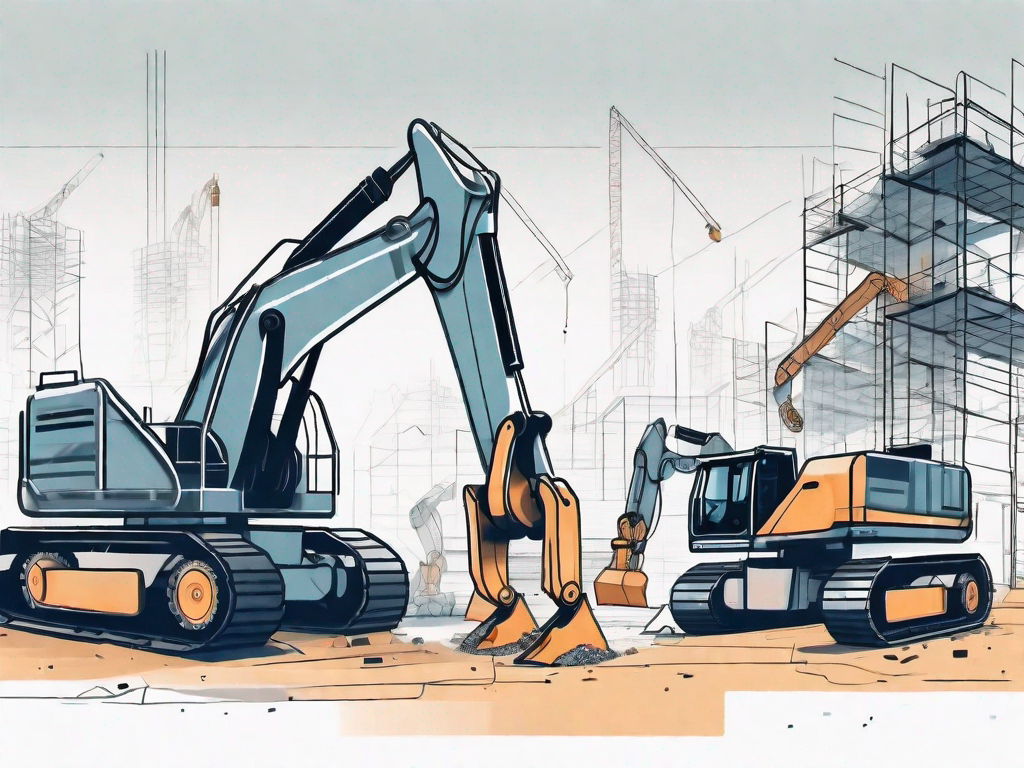Waste Not: AI-Driven Strategies for Construction Waste Management
Construction waste is a significant environmental issue that demands attention and innovative solutions. The construction industry generates a large volume of waste, including demolition debris, leftover materials, and packaging. This waste not only occupies valuable landfill space but also contributes to pollution and resource depletion. However, with the rapid advancement of technology, particularly artificial intelligence (AI), there is hope for improving construction waste management practices.
The Impact of Construction Waste on the Environment
Before delving into the use of AI in construction waste management, it is crucial to understand the scope and environmental consequences of construction waste. Construction waste encompasses a wide range of materials, such as concrete, wood, metal, plastics, and hazardous substances. These materials, when not properly managed, can contaminate soil and water sources, emit harmful gases, and degrade ecosystems.
Construction waste is a significant issue that affects not only the environment but also human health. The sheer volume of waste generated by construction activities is staggering. In the United States alone, it is estimated that the construction industry produces over 160 million tons of waste each year. This waste ends up in landfills, where it takes up valuable space and contributes to greenhouse gas emissions.
Furthermore, construction waste can have long-term consequences on ecosystems. Improper disposal of hazardous substances, such as asbestos or lead-based paint, can contaminate soil and water, posing risks to both wildlife and human populations. Additionally, the extraction of raw materials for construction purposes can lead to deforestation and habitat destruction, further exacerbating biodiversity loss.
How can the construction industry address these environmental challenges effectively and efficiently? Is AI the key to mitigating the negative impact of construction waste?
Understanding the Scope of Construction Waste
Construction waste includes various types of waste, ranging from structural debris and excavated materials to packaging and temporary structures. To effectively manage construction waste, it is essential to categorize and quantify the waste produced at different stages of a construction project. Understanding the types and quantities of waste generated helps identify opportunities for reduction, recycling, and proper disposal.
One way to address construction waste is through the implementation of waste management plans. These plans outline strategies for waste reduction, recycling, and responsible disposal. By carefully tracking the materials used in construction projects and implementing recycling programs, the industry can significantly reduce its environmental footprint.
Environmental Consequences of Improper Construction Waste Management
Improper construction waste management can have severe environmental consequences. Waste disposal in landfills contributes to greenhouse gas emissions and creates the risk of soil and water contamination. Incineration of construction waste releases harmful pollutants into the air, further deteriorating air quality. These consequences highlight the urgent need for sustainable waste management strategies in the construction industry.
One promising solution to mitigate the environmental impact of construction waste is the use of artificial intelligence (AI). AI-driven technologies can help optimize waste management processes, leading to more efficient and sustainable practices. For example, AI algorithms can analyze data on waste generation, transportation routes, and recycling facilities to identify the most effective ways to minimize waste and reduce carbon emissions.
AI can also play a crucial role in improving the sorting and recycling of construction waste. With AI-powered robotic systems, it is possible to automate the separation of different materials, such as concrete, wood, and metal, making the recycling process more efficient and cost-effective. Additionally, AI can assist in identifying hazardous substances in construction waste, ensuring their proper handling and disposal.
Furthermore, AI can facilitate the development of predictive models that help construction companies anticipate waste generation and plan accordingly. By analyzing historical data and construction project parameters, AI algorithms can provide insights into the expected waste quantities and types, allowing for better waste management strategies.
In conclusion, the environmental impact of construction waste is a significant concern that requires immediate attention. The construction industry must adopt sustainable waste management practices to mitigate the negative consequences on the environment and human health. AI offers promising solutions by optimizing waste management processes, improving recycling efforts, and enabling more informed decision-making. By harnessing the power of AI, the construction industry can pave the way towards a greener and more sustainable future.
The Role of AI in Construction Waste Management
Artificial intelligence has gained prominence in various industries, and its potential in the construction sector is immense. AI technologies, such as machine learning and predictive analytics, can provide valuable insights and improve decision-making in construction waste management.
Introduction to AI in the Construction Industry
The construction industry embraces automation and digitalization to enhance productivity and efficiency. AI, with its ability to analyze vast amounts of data and identify patterns, offers new opportunities for optimizing construction processes. By harnessing AI, construction companies can make informed decisions and achieve sustainable waste management practices.
How can AI be integrated into the construction workflow? What are the potential benefits and challenges of adopting AI in waste management?
How AI Can Revolutionize Construction Waste Management
AI-driven technologies hold great promise for revolutionizing construction waste management. Machine learning algorithms can analyze historical construction data to predict waste generation patterns, allowing companies to plan and allocate resources efficiently. Real-time monitoring systems equipped with AI can track waste management activities, ensuring compliance with regulations and identifying areas for improvement.
What are some real-life examples of AI-driven waste management solutions in the construction industry? How can AI help optimize waste sorting and recycling processes?
AI-Driven Strategies for Construction Waste Reduction
To effectively reduce construction waste, AI can be leveraged to implement proactive strategies throughout the construction project lifecycle. These strategies focus on waste forecasting, real-time monitoring, and automated sorting and recycling systems.
Predictive Analytics for Construction Waste Forecasting
Predictive analytics, powered by AI, enables construction companies to anticipate waste generation patterns and plan accordingly. By analyzing historical data and considering factors such as project type, timeline, and materials used, AI algorithms can provide accurate waste forecasts. This proactive approach helps optimize waste management strategies and reduce overall waste generation.
How can construction companies leverage predictive analytics to forecast waste generation? What are the benefits of accurate waste forecasting for construction projects?
Real-Time Monitoring and Tracking of Construction Waste
Incorporating AI into waste monitoring and tracking systems allows construction companies to have real-time visibility into waste generation, collection, and disposal. Data collected through sensors and IoT devices can be analyzed using AI algorithms, providing insights and identifying areas where waste reduction measures can be implemented. Real-time monitoring ensures regulatory compliance and facilitates continuous improvement in waste management practices.
How can real-time waste monitoring systems contribute to proactive waste management? Are there any challenges associated with implementing these monitoring systems?
Automated Sorting and Recycling Systems
The traditional process of manual waste sorting poses challenges in terms of efficiency and accuracy. AI-driven automated sorting systems utilize computer vision and robotics to identify and segregate different types of waste. These systems can significantly increase recycling rates and reduce the amount of waste sent to landfills.
What are the benefits of AI-powered automated sorting systems in construction waste management? How can these systems be integrated into existing waste management infrastructure?
Case Studies: Successful Implementation of AI in Construction Waste Management
To illustrate the practical applications and benefits of AI in construction waste management, let's explore two real-world case studies.
Case Study 1: AI-Driven Waste Management in Large-Scale Construction Projects
In this case study, a multinational construction company implemented an AI-based waste management system for a large-scale infrastructure project. By analyzing historical construction data and using predictive analytics, the company accurately forecasted waste generation and optimized waste management operations. Real-time monitoring systems identified inefficiencies and enabled immediate corrective actions.
What were the key outcomes of this AI-driven waste management system? How did it contribute to waste reduction and environmental sustainability?
Case Study 2: AI-Based Waste Sorting and Recycling in Sustainable Building Projects
In this case study, a sustainable building project utilized AI-powered automated sorting systems to handle construction waste efficiently. The systems accurately identified and sorted different types of waste, increasing recycling rates and reducing waste sent to landfills. The project demonstrated the potential of AI-driven waste management solutions in promoting sustainability in the construction industry.
What were the challenges faced during the implementation of automated sorting systems? How did these systems contribute to achieving the project's sustainability goals?
Challenges and Limitations of AI in Construction Waste Management
While AI offers groundbreaking possibilities for construction waste management, there are challenges and limitations that need to be considered.
Data Collection and Integration Challenges
Effective AI implementation requires reliable and comprehensive data. However, construction projects often face difficulties in collecting, integrating, and maintaining high-quality data throughout the project lifecycle. Overcoming data collection and integration challenges is crucial to leveraging AI effectively for waste management.
What are the key data collection challenges in the construction industry? How can construction companies address these challenges and ensure data quality for AI-driven waste management systems?
Cost and Implementation Challenges
Integrating AI technologies into existing construction waste management practices may require significant investments. Companies need to carefully evaluate the costs and benefits associated with AI adoption, ensuring that it aligns with their sustainability goals and overall business strategy. Additionally, implementation challenges such as the need for specialized expertise and potential resistance to change must be addressed.
What are the potential barriers to implementing AI in construction waste management? How can these barriers be overcome?
Ethical Considerations in AI-Driven Construction Waste Management
As AI becomes more prevalent in waste management, ethical considerations arise. Privacy concerns, algorithm bias, and the responsible handling of collected data are some of the ethical challenges that need to be addressed. Balancing technological advancements with ethical concerns is crucial for the successful and responsible implementation of AI in construction waste management.
What are the ethical implications of AI in construction waste management? How can construction companies ensure ethical use of AI technologies for waste management?
Conclusion
Construction waste management is a pressing issue that demands innovative solutions. The integration of AI technologies offers new opportunities for optimizing waste management processes, reducing waste generation, and promoting sustainability in the construction industry. Through predictive analytics, real-time monitoring, and automated sorting systems, AI can revolutionize how construction waste is managed.
However, challenges such as data collection, implementation costs, and ethical considerations need to be carefully addressed. The full potential of AI in construction waste management can only be realized through collaboration, knowledge exchange, and continuous improvement.
How can the construction industry as a whole embrace AI-driven strategies for waste management? What role can policymakers and regulatory bodies play in promoting AI adoption for sustainable construction practices? It is by addressing these questions and working collectively that we can pave the way for a future where construction waste is minimized, resources are preserved, and the environment is protected.





